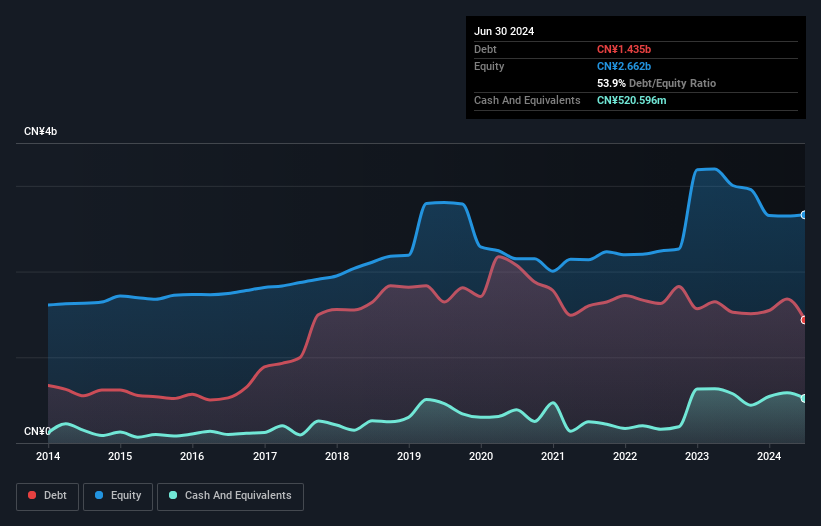Howard Marks put it nicely when he said that, rather than worrying about share price volatility, 'The possibility of permanent loss is the risk I worry about... and every practical investor I know worries about.' When we think about how risky a company is, we always like to look at its use of debt, since debt overload can lead to ruin. We can see that Zhanjiang Guolian Aquatic Products Co., Ltd. (SZSE:300094) does use debt in its business. But is this debt a concern to shareholders?
What Risk Does Debt Bring?
Generally speaking, debt only becomes a real problem when a company can't easily pay it off, either by raising capital or with its own cash flow. In the worst case scenario, a company can go bankrupt if it cannot pay its creditors. However, a more common (but still painful) scenario is that it has to raise new equity capital at a low price, thus permanently diluting shareholders. By replacing dilution, though, debt can be an extremely good tool for businesses that need capital to invest in growth at high rates of return. The first thing to do when considering how much debt a business uses is to look at its cash and debt together.
How Much Debt Does Zhanjiang Guolian Aquatic Products Carry?
The image below, which you can click on for greater detail, shows that Zhanjiang Guolian Aquatic Products had debt of CN¥1.44b at the end of June 2024, a reduction from CN¥1.53b over a year. On the flip side, it has CN¥520.6m in cash leading to net debt of about CN¥914.8m.

A Look At Zhanjiang Guolian Aquatic Products' Liabilities
 According to the last reported balance sheet, Zhanjiang Guolian Aquatic Products had liabilities of CN¥1.86b due within 12 months, and liabilities of CN¥377.3m due beyond 12 months. On the other hand, it had cash of CN¥520.6m and CN¥445.9m worth of receivables due within a year. So it has liabilities totalling CN¥1.27b more than its cash and near-term receivables, combined.
According to the last reported balance sheet, Zhanjiang Guolian Aquatic Products had liabilities of CN¥1.86b due within 12 months, and liabilities of CN¥377.3m due beyond 12 months. On the other hand, it had cash of CN¥520.6m and CN¥445.9m worth of receivables due within a year. So it has liabilities totalling CN¥1.27b more than its cash and near-term receivables, combined.
While this might seem like a lot, it is not so bad since Zhanjiang Guolian Aquatic Products has a market capitalization of CN¥3.93b, and so it could probably strengthen its balance sheet by raising capital if it needed to. But we definitely want to keep our eyes open to indications that its debt is bringing too much risk. The balance sheet is clearly the area to focus on when you are analysing debt. But you can't view debt in total isolation; since Zhanjiang Guolian Aquatic Products will need earnings to service that debt. So if you're keen to discover more about its earnings, it might be worth checking out this graph of its long term earnings trend.
In the last year Zhanjiang Guolian Aquatic Products had a loss before interest and tax, and actually shrunk its revenue by 22%, to CN¥4.2b. To be frank that doesn't bode well.
Caveat Emptor
Not only did Zhanjiang Guolian Aquatic Products's revenue slip over the last twelve months, but it also produced negative earnings before interest and tax (EBIT). To be specific the EBIT loss came in at CN¥307m. Considering that alongside the liabilities mentioned above does not give us much confidence that company should be using so much debt. So we think its balance sheet is a little strained, though not beyond repair. We would feel better if it turned its trailing twelve month loss of CN¥328m into a profit. So in short it's a really risky stock. The balance sheet is clearly the area to focus on when you are analysing debt. However, not all investment risk resides within the balance sheet - far from it. For example, we've discovered 2 warning signs for Zhanjiang Guolian Aquatic Products (1 shouldn't be ignored!) that you should be aware of before investing here.
Of course, if you're the type of investor who prefers buying stocks without the burden of debt, then don't hesitate to discover our exclusive list of net cash growth stocks, today.
Have feedback on this article? Concerned about the content? Get in touch with us directly. Alternatively, email editorial-team (at) simplywallst.com.
This article by Simply Wall St is general in nature. We provide commentary based on historical data and analyst forecasts only using an unbiased methodology and our articles are not intended to be financial advice. It does not constitute a recommendation to buy or sell any stock, and does not take account of your objectives, or your financial situation. We aim to bring you long-term focused analysis driven by fundamental data. Note that our analysis may not factor in the latest price-sensitive company announcements or qualitative material. Simply Wall St has no position in any stocks mentioned.

